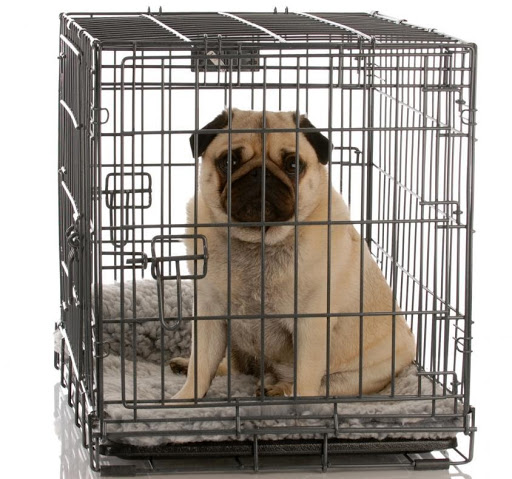If it’s your first time as a dog owner or you’re completely new to crate training, leaving your little pet pooch inside a crate while you sleep may not sit right with you, and understandably so. Your dog may whine all night, making it seem like he’s being tortured.
However, before you can come with all sorts of theories about dog owners who like to leave their dogs in a crate during nighttime hours, let’s answer this question once and for all: Is it cruel to crate a dog at night?
Whilst crating your dog at night may seem cruel it is not so because dogs are essentially denning animals and prefer to sleep in snug places. A crate or kennel can offer your dog that same sense of security, in order for it to feel safe and protected.
A crate can be a cozy retreat for your dog or a downright prison, but it all depends on your crate training skills and perspective. Since dogs are known to have a natural denning instinct, they are predisposed to prefer a safe and closed space for their naps.
Crate training done properly is highly effective in housebreaking your dog which can be a lifesaver for dog parents.
If you introduce the crate to your dog when it’s still a pup, it will think of it as a safe place to feel protected, a place where it can get some quiet to do some serious snoozing away from the hustle and bustle of the house.
You’ll be surprised to learn that wild dogs can spend a maximum of 16 hours a day sleeping. It just goes to show that rest periods in cozy and snug spaces are essential for dogs as it allows them to save energy for life-sustaining activities.
Ideal Crates For Your Dogs
When choosing a crate for your dog you should choose one that allows free movement. The dog crate should allow your dog to stretch out fully and sit up comfortably in the crate. It can be made of a number of different types of materials – wood, wire, plastic or fabric like canvas.
Be careful though because puppies like to chew things and a wooded crate may not be safe. Young puppies may urinate in their crates, wood has pores and dog urine may soak into those pores causing it to reek of urine scent in the house.
Too Much Time in a Crate Can Be Disastrous
While resting is important, you shouldn’t forget that your dog may have other needs that a crate may end up interfering with. Since dogs are known to be social animals, they need to spend time interacting with the outside world, whether it involves other dogs or friendly strangers.
Additionally, they also require mental stimulation, exercise, and appropriate opportunities for them to comfortably do their business. This is why, getting your dogs to spend a little bit of time in a crate can be positive, but too much time can be quite disastrous for them.
What To Do If Your Dog Whines as a Response to Crate Training
If your dog whines when you’re trying to crate train him, you shouldn’t worry because this is a completely normal response. With time, your dog will learn to acclimate to the crate and begin to feel comfortable sleeping in it.
However, it’s worth noting that there can be a couple of reasons why your dog may be whining when you put him in a crate. Some of them may easily be dealt with by waiting it out and letting the whining take its course, while, in some cases, you may need to be a little proactive and identify if there’s something about the crate that’s making him uncomfortable.
Your dog may also whine and cry all night just to get your attention. This can happen during the early days of crate training when you’re still trying to help treat his separation anxiety. If you take them out of the crate in an effort to console them, you’ll end up setting yourself back in the training process and give your dog the idea that it’s okay for him to whine all night.
You need to let your dog calm down on his own and soothe himself to sleep. This will allow him to feel more and more at home in the crate and eventually grow used to sleeping in it with no difficulties.
If you’ve tried everything to get your dog to calm down, you may want to take him to the vet to make sure there aren’t any underlying issues. Sometimes, your dog’s whining may not have anything to do with the crate, which is why you need to keep an eye on their health. You can also consider changing the crate to see if he reacts any differently.
How to Make Sure Your Dog is Comfortable in the Crate
It’s no secret that your pups will be on their best behavior if you’re meeting all of their needs. One of the biggest challenges of training dogs is managing their energy levels and making sure they have an appropriate outlet where they can utilize all of the excess energy that’s been building up inside them all day.
To make sure your dog won’t freak out in the crate, you need to take him on a good walk just before his bedtime so he can let out all of that energy. By the time you get back, he’ll be tired and wouldn’t want to cause a commotion in the house.
You can also play a game of fetch with your dog if he seems to have higher energy levels than most other dogs you’ve come across so that once you put him into the crate, he won’t feel uncomfortable.
Don’t Use the Crate as Punishment; It Should Be A Happy Place
It goes without saying, but you should use a create to teach your dog fundamental behaviors. If your dog is quite stubborn, you will be tempted to lock him up but that’s something you should never do. If you use the crate as punishment, it will no longer remain a happy and cozy place for your dog.
He will begin to associate negative feelings with the crate and fight you whenever you try to put him inside it. Forcing your dog to enter the crate will make him feel miserable and you’ll end up undoing all of the crate training progress you had made.
You need to be patient and give your dog time to become familiar with the crate so he will want to enter it voluntarily around nighttime.
Final Words
So, is it cruel to crate a dog at night? No, it is not cruel to crate your dog at night unless you’re using it as punishment. You may not know this, but crate training can take anywhere from one week to a whole year because every dog is different.
If you’ve tried and experimented with all the tips we’ve shared above and you still can’t get your dog to calm down at night, you may need to get in touch with a professional dog trainer.
Alternatively, you can try the scientific method of brain training your dog by purchasing the brain training for dog course written by Adrienne Farricelli. The link will take you to a blog post where I reviewed the course. I believe it to be a great course if you purchase the product I will make a small commission. It does not affect how much you pay.
Visit Dogbabe for more tips on becoming the best owner for your furry friends!














